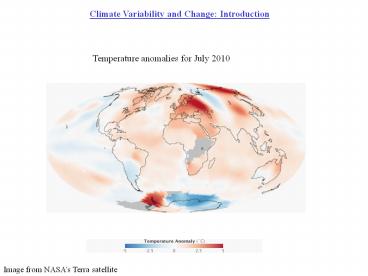Climate Variability and Change: Introduction PowerPoint PPT Presentation
Title: Climate Variability and Change: Introduction
1
Climate Variability and Change Introduction
Temperature anomalies for July 2010
Image from NASAs Terra satellite
2
Climate Variability and Change Introduction
Temperature anomalies for July 2010
Eastern Europe 5C warmer than climatology
severe wildfires and smoke
Image from NASAs Terra satellite
3
Climate Variability and Change Introduction
Temperature anomalies for July 2010
Eastern US unusual heat
Eastern Europe 5C warmer than climatology
severe wildfires and smoke
Image from NASAs Terra satellite
4
Climate Variability and Change Introduction
Temperature anomalies for July 2010
Eastern US unusual heat
Parts of S. America sub-freezing temperatures
and heavy snow hundreds of cold-related deaths
Eastern Europe 5C warmer than climatology
severe wildfires and smoke
Image from NASAs Terra satellite
5
Climate Variability and Change Introduction
What are the causes of the observed anomalies?
Image from NASAs Terra satellite
6
Climate Variability and Change Introduction
Can we predict these anomalies a season ahead?
Image from NASAs Terra satellite
7
Climate Variability and Change Introduction
Is the hot summer in Eastern Europe part of a
global warming signal?
Image from NASAs Terra satellite
8
Climate Variability and Change Introduction
Is the hot summer in Eastern Europe part of a
global warming signal caused by us?
Image from NASAs Terra satellite
9
Climate Variability and Change Introduction
The global average temperature for July 2010 was
0.55C warmer than climatology (51-80). Is this a
global warming signal?
Image from NASAs Terra satellite
10
Climate Variability and Change Introduction
Floods in Pakistan
Floods caused by torrential monsoon rains More
than 1,600 people have died and about 6Million
are homeless - about 17 million people have been
affected
11
Climate Variability and Change Introduction
Floods in Niger, West Africa
Heavy rains in August and resulting floods have
left more than 100,000 people homeless (UN).
12
(No Transcript)
13
The Sahel (15-20N)
14
Climate and its variability impacts society (e.g.
food and water resources, health, energy and
demography)
15
Climate Variability Matters!
16
Climate Variability matters!
Bonnie (05)
Charlie (05)
Frances (05)
Flooding in New Orleans due to Katrina
(courtesy NOAA)
Ivan (05)
courtesy A. Aiyyer
17
(No Transcript)
18
Science and Society Interact
Society demands useful predictions of climate so
that it can respond to climate variability. One
key question to ask is What do the users of
these forecasts need? In recent years most
seasonal predictions have been concerned with
providing the mean seasonal rainfall anomaly
not always useful. Users tend to want more than
this when will the rainy season start? How will
the rainfall be distributed within the season
(weather?)? These are much harder to predict.
19
Limits of predictability weather
theoretically 1-2 weeks TOPS! currently much
less than this, probably around 5 days or so
limitations include poor models and poor
observations of the atmosphere especially climat
e forecasts are made at seasonal-to-interannual
and multi-decadal timescales (including climate
change) limitations include poor models, poor
observations of climate system includes land
and ocean , less important for weather.
20
- Seasonal-to-Interannual variability
- We will discuss the basis for these forecasts in
this course. - Need to understand causes of seaonal-to-interannua
l variability.
At these timescales it is crucial to provide
information on the status of ENSO and to be able
to predict the impacts of ENSO locally and around
the globe (teleconnections).
21
- Interdecadal Fluctuations and Trends
- Efforts are also made to make predictions on
longer timescales
22
Introduction to the course
23
Section 1 Introduction to the Climate
System Provides background to the mean climate
system, combines observations of key variables of
the climate system and a physical understanding
of key processes. These sections are required for
a basic understanding of the climate system and
processes before we can attempt to consider its
variability. Many textbooks exist that cover
these areas.
24
Section 2 Natural Climate Variability We will
consider the nature of observed
seasonal-to-interannual variability (things we
wish to predict) - Most importantly in this
section is ENSO (observations, mechanisms and
impacts (teleconnections). In addition we will
discuss decadal variability important to be
aware of this when attempting to attribute
anomalies to a global warming trend. We will
discuss how climate predictions are made Finally
we will consider how climate variability is
manifested in changes in high impact weather.
25
Section 3 Climate Change We will consider the
theory of climate change We will look at the
observational evidence as well as how climate
predictions are consistent (or not) with
this. The IPCC process will be discussed
26
Section 4 Future Perspectives We will finish
with some discussion on how science and society
are interacting with regards to climate
variability and change.
27
ANY REQUESTS?
28
"climate is what you expect and weather is
what you get." "climate tells you what clothes
to buy, but weather tells you what clothes to
wear."

